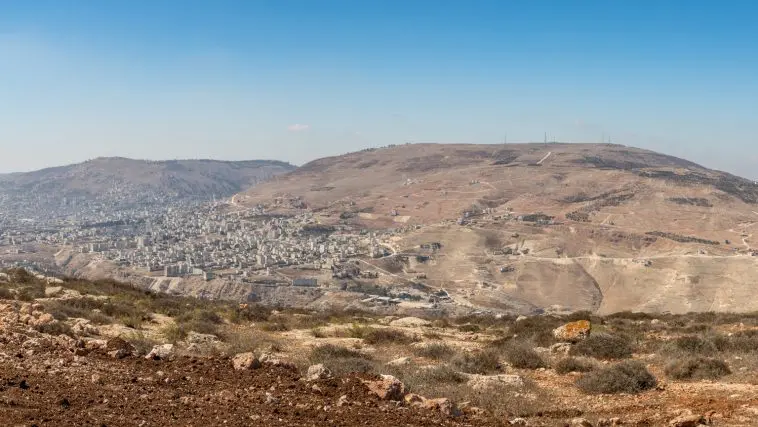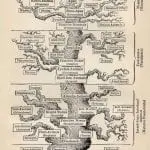In the preceding articles of this series, we considered in Part 1 the evolutionary philosophical foundations of modern academia and how it conditions the interpretation of literally everything in every subject including archaeology.
In Part 2 we looked at the Brooklyn Papyrus which attests to the presence of the Israelites in ancient Egypt during the 13th Dynasty (1600s BC).
In Part 3, we examined the earliest extant “Yahweh” inscription attesting to the existence of the worshippers of Yahweh at right about 1400 BC on the Soleb temple of Pharaoh Amenhotep III.
In Part 4, we saw the correlation of the El Amarna letters (1300s BC) with the biblical record of the Israelite invasion of Canaan.
And, in Part 5, we considered the connection between the account of the plagues on Egypt in Exodus with the Papyrus of Ipuwer. The cumulative weight of this extra-biblical evidence is a powerful confirmation of the historicity of Genesis and Exodus. Next, we are going to move to the Land of Israel to continue our examination of the archaeological remains attested to in the Bible.
The Altar of Joshua
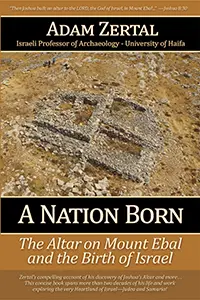
There are many significant archaeological discoveries that relate to the Bible in biblical lands. My personal favorite, and certainly one of the top three or four most significant, is the discovery of Joshua’s altar on Mount Ebal.
The altar (or more precisely the altars, plural) was discovered on Mount Ebal by Israeli archaeologist, Adam Zertal, Professor of Archaeology, at the University of Haifa. Zertal did his nine-year-long excavation of the Mount Ebal site in the 1980s and chronicled the story of the discovery and excavation of the site in his book, A Nation Born, subtitled, “The Altar on Mount Ebal and the Birth of Israel.” (Click this link to purchase A Nation Born.)
Zertal also previously conducted the first-ever archaeological survey of the territory of Manasseh, in which territory Mount Ebal is situated in the central highlands of Israel. The archaeology of his Manasseh survey detailed the entry of the Israelites into Canaan from the east, from Transjordan, and their expansion outward from that location. Also worth reading is Joshua’s Altar, subtitled “The Dig at Mount Ebal” by journalist Milt Machlin.
Bible Passages Concerning Joshua’s altar and Mount Ebal:
An altar of earth you shall make for me and sacrifice on it your burnt offerings and your peace offerings, your sheep and your oxen…If you make me an altar of stone, you shall not build it of hewn stones, for if you wield your tool on it you profane it. And you shall not go up by steps to my altar… (Exodus 20:24–26a)
“And when the Lord your God brings you into the land that you are entering to take possession of it, you shall set the blessing on Mount Gerizim and the curse on Mount Ebal. Are they not beyond the Jordan, west of the road, toward the going down of the sun, in the land of the Canaanites…?” (Deuteronomy 11:29–30)
Now Moses and the elders of Israel commanded the people, saying, “Keep the whole commandment that I command you today. And on the day you cross over the Jordan to the land that the Lord your God is giving you, you shall set up large stones and plaster them with plaster. And you shall write on them all the words of this law, when you cross over to enter the land that the Lord your God is giving you… And when you have crossed over the Jordan, you shall set up these stones, concerning which I command you today, on Mount Ebal, and you shall plaster them with plaster. And there you shall build an altar to the Lord your God, an altar of stones. You shall wield no iron tool on them; you shall build an altar to the Lord your God of uncut stones. And you shall offer burnt offerings on it to the Lord your God, and you shall sacrifice peace offerings and shall eat there, and you shall rejoice before the Lord your God. And you shall write on the stones all the words of this law very plainly. (Deuteronomy 27:1–8)
“See, I am setting before you today a blessing and a curse: the blessing, if you obey the commandments of the Lord your God, which I command you today, and the curse, if you do not obey the commandments of the Lord your God, but turn aside from the way that I am commanding you today, to go after other gods that you have not known. And when the Lord your God brings you into the land that you are entering to take possession of it, you shall set the blessing on Mount Gerizim and the curse on Mount Ebal.” (Deuteronomy 27:26–29)
At that time Joshua built an altar to the Lord, the God of Israel, on Mount Ebal, just as Moses the servant of the Lord had commanded the people of Israel, as it is written in the Book of the Law of Moses, “an altar of uncut stones, upon which no man has wielded an iron tool.” And they offered on it burnt offerings to the Lord and sacrificed peace offerings. And there, in the presence of the people of Israel, he wrote on the stones a copy of the law of Moses, which he had written. And all Israel, sojourner as well as native born, with their elders and officers and their judges, stood on opposite sides of the ark before the Levitical priests who carried the ark of the covenant of the Lord, half of them in front of Mount Gerizim and half of them in front of Mount Ebal… Joshua 8: 30–33
Mysteriously, thereafter both Mount Ebal and Joshua’s altar disappear altogether from the biblical record, never to be mentioned again.
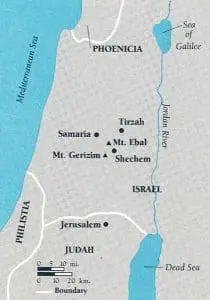
What Did Zertal Find on Mount Ebal?
Among the discoveries at the Mount Ebal site, Zertal unearthed an unmistakably Israeli altar of uncut stones, consisting partly of a ramp ascending to a height of about 9 feet (3 meters) to the sacrificial area in conformity to the command of God in Exodus 20, “you shall not go up by steps to my altar.” This is distinct from Canaanite altars which, without exception, have stair steps up to the sacrificial areas.
There were also discovered burned bones and ash (that is, burnt offerings) in pits all of which were, also without exception, from kosher animals. There was also an Egyptian scarab found with the inscription of Pharaoh Thutmose III (reign 1504–1450 BC), suggesting an early date of late 15th century BC for the establishment of the site, a second Egyptian scarab apparently from the 13th century BC, and gold and silver Egyptian earrings. These testify to some connection with Egypt despite being found in the eastern hill country of Manasseh (that is, on the far side of Canaan from Egypt).
There was also plaster discovered at the site, echoing Deuteronomy 27.
The site on Mount Ebal yielded another amazing discovery: the altar was built directly over top of a smaller and older circular altar located in the precise geometric center of the sacrificial area of the second altar! This older and smaller altar is, undoubtedly, the altar of Joshua spoken of in the book of Joshua which, following the biblical chronology, was erected in 1406 BC.
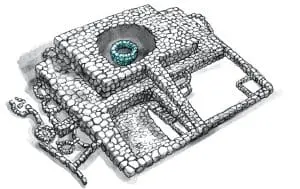
In the illustration above, note the ramp leading up to the sacrificial platform and the positioning of the older circular altar underneath. Zertal did not find the newer altar open to the smaller altar underneath, as in the illustration, but covered with the platform of the second altar. The illustration was done to show the positioning of the older altar underneath.
Zertal discovered the site had been deliberately covered up in antiquity and completely buried intact with a heap of stones. Zertal proposed that the site was covered up when the Tabernacle was moved from the city of Shechem, which sits at the foot of Mount Ebal, to Shiloh. This is the most probable explanation for the burial of the altars, but we could also surmise that they were possibly covered up to prevent desecration in anticipation of an expected enemy invasion.
There simply is no written record to shed any light on the rationale for this. Ultimately, any explanation for the burial of the site is an educated guess. It does seem reasonable to surmise that the cessation of the use of the site was followed by the establishment of an altar at another location. This altar was (or these altars were) intact with the exception of some damage caused by an earthquake.
“See no evil, hear no evil…”
Not everyone was happy about this find. The discovery, which was clearly connected with specific passages in the Bible, was utterly anathema to the secular academic establishment, who were and are, profoundly committed to the “mythological” categorization of early biblical history, including the history of Moses and the Israeli conquest of Canaan.
The discovery of something so early in biblical Israel’s history, from the late fifteenth century BC according to biblical chronology, and directly connected to specific biblical passages in Deuteronomy and Joshua, was like a high-magnitude earthquake in the secular academic world.
It was also anathema to the Islamic world as noted by Zertal:
An awakening Palestinian nationalism also saw the biblical revelation as a serious threat. Arab intellectuals insisted that the Bible was not a historical book, and therefore could not be used to claim any territorial rights. – pg 92, A Nation Born.
(The topic of how the interpretation of archaeological findings in the Middle East is influenced by Islamic sensitivities is a subject worthy of its own story and ought to be the subject of some academician’s PhD thesis!)
A similar thought was expressed by Zertal’s publisher: “[Zertal’s] peers and colleagues were silent; unwilling to react to his compelling findings. To do so would cause a major earthquake in the field of Biblical Archaeology; or as Professor Lawrence E. Stager, Dorot Professor of the Archaeology of Israel…stated, ‘If there is an altar on Mt. Ebal, as Zertal claims, we — biblical scholars — should all go back to kindergarten’.”
Not a bad suggestion!
It is essential to understand from the outset the mindset, presuppositions, and biases that secular academicians bring to the table in their approach to biblical archaeology (or any subject, for that matter.) To that end, we need to consider again the comments of Richard Lewontin, one of the “High Priests” of secular academia:
We have a prior commitment, a commitment to materialism…. It is not that the methods and institutions of science somehow compel us to accept a material explanation of the phenomenal world, but, on the contrary, that we are forced by our a priori adherence to material causes to create an apparatus of investigation and a set of concepts that produce material explanations, no matter how counter-intuitive, no matter how mystifying to the uninitiated. Moreover, that materialism is absolute, for we cannot allow a Divine Foot in the door.
Billions and Billions of Demons ~Richard Lewontin, review of The Demon-Haunted World: Science as a Candle in the Dark by Carl Sagan, 1997, The New York Review, p. 31, Jan. 9, 1997.
Who was Adam Zertal?
Was Zertal a biblical fanatic bent on misrepresenting the archaeology in the ground in pursuit of an a priori commitment to biblical literalism? The Publisher’s Note of Zertal’s book, A Nation Born, described Zertal as “a non-religious, high ranking scholar.” This accords with Zertal’s self-description to journalist Milt Machlin:
“Personally…I am not very religious, and I do not think that every word of the Bible was dictated by God. But I think the Bible is a valuable tool, and I would certainly not have found the site of Dothan, or Solomon’s Third District, without it as a guide.” (Joshua’s Altar, pg 104 by Milt Machlin)
Coming to Difficult — but Obvious — Conclusions
On page 64 of A Nation Born, Zertal states, “My academic background made it difficult for me to accept the idea of Joshua’s altar as a tangible reality. After all, Moses is not a historical figure.”
In other words, Zertal was indoctrinated with the standard secular approach of modern academia, which excludes, as a matter of fundamental presupposition, any hint of a supernatural reality, of God, of the historicity of the Pentateuch, or esoteric ideas like the inspiration of Scripture. Regarding the Bible specifically, it is treated as a book of myths and fables rather than historical information.
But when you scrutinize the proponents and their arguments for this approach to Scripture, it is found that the only reason the biblical witness is denied is because of the record of supernatural events that it contains. Otherwise, the biblical records of people, places, and events would be accepted just like any other ancient documents. The Bible, without any valid justification whatsoever, is treated suspiciously differently in this regard than other ancient historical records. They are simply unwilling to let a divine foot in the door!

…And Then There’s Politics
There is also a political aspect of Zertal’s background and education which is worth noting. On page 98 of Joshua’s Altar, Milt Machlin states:
“Adam is the son of one of the early leaders of the Mapam, a party aligned with Labor for many years…whose philosophy ruled the kibbutz. Mapam is the political offshoot of the Hashomer Hatzair…Movement, which began in Poland and Russia in the early 1920s, and set up the kibbutzim in Israel. Their movement was not the largest, but was certainly very active in settling areas that were densely populated by Arabs. Their original philosophy called for a dual-nationality state of Jews and Arabs. They were and are the farthest left-wing movement (aside from the Communists) in Israel, and their political wing, Mapam, is in opposition to the Likud ruling bloc…
They are staunchly in favor of a Palestinian state on the West Bank, and as a group are against West Bank settlement by the Israelis. Their philosophy, to this day, includes an almost total rejection of Jewish traditions.
For example, only their kibbutzim will raise pigs, and Yom Kippur is more or less just another working day. The movement as a whole idealized Russia…”
That is to say, Communist Russia, the Soviet Union. There could therefore be no bias on Zertal’s part to confirm Scripture. Quite the contrary, the archaeological evidence forced Zertal’s hand against his biases, in opposition to his academic training, and contrary to his expectations. Zertal did not go to Ebal with an agenda of looking for Joshua’s altar.
Zertal’s Assessment of His Critics
The reaction of the secular academic establishment to Zertal’s discovery is worth noting. Zertal states:
“Confused murmurs could be heard within the ivory towers. As is every academic’s first instinct, doubts were immediately cast. Among some marginal groups, I was branded a ‘nineteenth-century’ or ‘religious’ archaeologist. Dirty words like ‘dubious’ and ‘imaginary’ were bandied about, and the pedants beat at their shields with claims that I was peddling ‘a contrived link between the Bible and archaeology.’ For the majority, their behavior did not stem from any malice, but they were loath to accept any discovery that clashed with the mainstream theories. Tellingly, the critics didn’t dare express their doubts in my presence, and never provided convincing arguments to back their contentions. None offered an alternative explanation for the site. The skeptics attacked our discovery and its significance without ever confronting the evidence. Our findings were so clear and straightforward, it was difficult to devise a rational argument to refute the relationship between the site and the Scriptures.” – pg 74, A Nation Born
Due to consideration of length, we will continue our examination of the discovery of Joshua’s altar in Evolution vs Biblical Archaeology Part 6B Other resources about Mount Ebal and Joshua’s altar:

